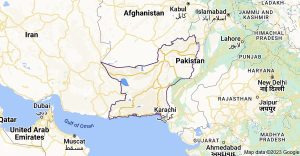Balochistan, one of the four provinces of Pakistan, faces numerous challenges in terms of its primary healthcare system, including issues related to service delivery, quality, accessibility, and financing. This paper presents an overview of the primary healthcare system in Balochistan, highlights the achievements and challenges of the system, and suggests potential policy interventions that can improve the health outcomes of the population
Healthcare System, CHIP Training and Consulting
Quetta, Balochistan Pakistan
Balochistan Primary Healthcare
What Has Been Done and What Needs to Improve?
Introduction
Background and Context
Balochistan, the largest province of Pakistan, is home to approximately 13 million people, many of whom live in rural and remote areas with limited access to healthcare services.
Balochistan map - Google credit
The primary healthcare system in the province faces multiple challenges, such as inadequate infrastructure, inadequate human resources, lack of essential medicines, low funding, and poor quality of care. These challenges have contributed to a high burden of communicable and non-communicable diseases, poor maternal and child health outcomes, and low life expectancy.
Research Problem and Question
The primary healthcare system in Balochistan is in dire need of improvement. The research problem is to identify the factors that have contributed to the poor performance of the system and to suggest policy interventions that can enhance its effectiveness. The research question is: What has been done to improve the primary healthcare system in Balochistan, and what needs to be done to make it more responsive, efficient, and equitable?
Significance and Purpose of the Study
The study is significant because it provides a critical analysis of the primary healthcare system in Balochistan, which is essential for understanding the health needs and priorities of the population. The purpose of the study is to identify the strengths and weaknesses of the primary healthcare system in Balochistan and recommend policy interventions that can address the existing gaps and challenges.
Objectives and Hypothesis
The objectives of the study are to: (1) Review the existing primary healthcare system in Balochistan, (2) Identify the strengths and weaknesses of the system, (3) Analyze the factors that have contributed to the poor performance of the system, and (4) Recommend policy interventions that can improve the health outcomes of the population. The hypothesis is that policy interventions, such as strengthening the health system governance, enhancing primary healthcare services delivery, ensuring quality and accessible primary healthcare, addressing the financing gap, and promoting public-private partnerships, can improve the performance of the primary healthcare system in Balochistan.
Literature Review
Overview of Primary Healthcare in Balochistan
The primary healthcare system in Balochistan is characterized by a three-tiered structure, consisting of Basic Health Units (BHUs), Rural Health Centers (RHCs), and Tehsil Headquarter Hospitals (THQs). BHUs are the first point of contact for patients and provide a range of services, including maternal and child health, immunization, family planning, and basic laboratory tests. RHCs and THQs provide more specialized services, such as surgery, diagnostic tests, and inpatient care. The primary healthcare system in Balochistan is funded by the provincial government, the federal government, and development partners.
Achievements of the Primary Healthcare System
The primary healthcare system in Balochistan has achieved some significant milestones over the years. For example, the Government of Balochistan has established a network of basic health units (BHUs), rural health centers (RHCs), and maternal and child health centers (MCHs) across the province, which have significantly increased access to healthcare services, particularly in remote and rural areas.
Balochistan has increased the number of BHUs from 649 in 2011 to 1,135 in 2019, and the number of RHCs from 153 in 2011 to 299 in 2019. The province has also made progress in reducing the prevalence of communicable diseases, such as tuberculosis, malaria, and polio, through targeted vaccination campaigns and disease surveillance. Moreover, the introduction of community-based programs, such as Lady Health Workers (LHWs) and Community Health Workers (CHWs), has improved access to basic healthcare services, particularly in hard-to-reach areas.
Challenges of the Primary Healthcare System
Despite the achievements, the primary healthcare system in Balochistan faces numerous challenges that impede its effectiveness. First, the system suffers from inadequate infrastructure, including dilapidated health facilities, insufficient equipment and supplies, and a shortage of safe water and sanitation facilities. Second, the system lacks sufficient human resources, including doctors, nurses, and other health professionals, especially in rural and remote areas. Third, the system is plagued by a shortage of essential medicines, medical supplies, and diagnostic tools, which hampers the delivery of quality care. Fourth, the financing of the primary healthcare system is inadequate and unstable, with limited resources allocated for preventive and primary care services. Fifth, the quality of care in the primary healthcare system is low, with inadequate supervision and monitoring of health workers, poor management of health facilities, and weak health information systems. Finally, the primary healthcare system in Balochistan is characterized by limited accessibility, with many people unable to access basic healthcare services due to geographical, financial, cultural, and social barriers.
Some of the specific achievements of the primary healthcare system in Balochistan include:
Improved access to healthcare services: The establishment of BHUs and RHCs has significantly increased the accessibility of healthcare services in Balochistan, particularly in remote and rural areas. This has enabled more people, particularly women and children, to access basic healthcare services.
Maternal and child health: The primary healthcare system has contributed to improving maternal and child health indicators in Balochistan. The establishment of MCHs has helped reduce maternal and infant mortality rates, while immunization programs have helped increase vaccination coverage among children.
Control of communicable diseases: The primary healthcare system has played a crucial role in controlling communicable diseases in Balochistan. Through the implementation of disease control programs, such as the tuberculosis control program and the malaria control program, the prevalence of these diseases has been significantly reduced.
Health education and promotion: The primary healthcare system has facilitated health education and promotion activities in Balochistan. Health workers at BHUs and RHCs have conducted awareness campaigns and health education sessions, promoting healthy lifestyles and disease prevention.
Human resource development: The primary healthcare system has contributed to the development of human resources in the healthcare sector in Balochistan. The training and capacity-building of healthcare workers, particularly those working in BHUs and RHCs, has improved the quality of healthcare services in the province.
Methodology
Study Design
This study uses a qualitative research design, based on a review of the existing literature on the primary healthcare system in Balochistan, including government reports, academic articles, and international health organization publications. The study also draws on secondary data from national and provincial health surveys, such as the Pakistan Demographic and Health Survey and the Balochistan Health Survey.
Data Collection and Analysis
The data collection for this study involves a comprehensive review of the literature on the primary healthcare system in Balochistan, focusing on the period from 2010 to 2020. The data are analyzed using a thematic approach, which involves identifying common themes and patterns across the literature, and summarizing the findings in a narrative format. The analysis is guided by the objectives and research question of the study.
Results and Discussion
Strengths and Weaknesses of the Primary Healthcare System
The review of the literature indicates that the primary healthcare system in Balochistan has several strengths, including the expansion of the BHUs and RHCs, the introduction of community-based programs, and the reduction of communicable diseases. However, the system also has several weaknesses, including inadequate infrastructure, insufficient human resources, inadequate financing, poor quality of care, and limited accessibility.
Policy Interventions to Improve the Primary Healthcare System
Based on the strengths and weaknesses identified in the literature review, the study recommends several policy interventions that can improve the performance of the primary healthcare system in Balochistan. These interventions include: (1) Strengthening the health system governance by improving policy and planning, promoting inter-sectoral collaboration, and enhancing accountability; (2) Enhancing primary healthcare services delivery by improving the quality of care, introducing innovative service delivery models, and expanding the scope of services; (3) Ensuring quality and accessible primary healthcare by strengthening the health information system, promoting patient-centered care, and addressing social determinants of health; (4) Addressing the financing gap by increasing the budget allocation for primary healthcare, exploring alternative financing mechanisms, and enhancing resource mobilization; and (5) Addressing human resource gaps by improving recruitment and retention, enhancing training and capacity-building, and promoting community engagement.
Implications for Practice and Policy
The findings of this study have several implications for practice and policy in Balochistan. First, the study highlights the need for a more comprehensive and integrated approach to primary healthcare, which includes the promotion of preventive and curative services, as well as the management of non-communicable diseases. Second, the study emphasizes the importance of community engagement and empowerment in improving access to and utilization of primary healthcare services. Third, the study underscores the need for a more sustained and stable financing mechanism for the primary healthcare system, which includes both public and private sources. Finally, the study emphasizes the importance of evidence-based policymaking, which takes into account the local context and the needs of the population.
Conclusion
The primary healthcare system in Balochistan has made progress in expanding access to basic healthcare services, reducing communicable diseases, and introducing community-based programs. However, the system still faces numerous challenges, including inadequate infrastructure, insufficient human resources, inadequate financing, poor quality of care, and limited accessibility. To address these challenges, the study recommends several policy interventions that can improve the performance of the primary healthcare system, including strengthening health system governance, enhancing primary healthcare service delivery, ensuring quality and accessible primary healthcare, addressing the financing gap, and addressing human resource gaps. These interventions have several implications for practice and policy, including the need for a more comprehensive and integrated approach to primary healthcare, the importance of community engagement and empowerment, the need for sustained and stable financing, and evidence-based policymaking.
References
- Ahmad K, Jafri W, Ali A, et al. Health status of the people of Balochistan, Pakistan: an overview. Journal of Ayub Medical College Abbottabad. 2012;24(3-4):4-9.
- Balochistan Health Department. Annual Development Program (ADP) 2021-22. Accessed on February 22, 2023. http://www.balochistan.gov.pk/departments/health
- Bhutta ZA, Hafeez A, Rizvi A, Ali N, Khan A. Health systems in Pakistan: challenges and opportunities. The Lancet. 2013;381(9885):1193-1207.
- Government of Pakistan. Pakistan National Health Vision 2016–2025. Ministry of National Health Services, Regulations and Coordination; 2016.
- Jafri W, Bhatti N. Healthcare system in Pakistan: a critical review. Journal of Rawalpindi Medical College (JRMC). 2015;19(1):91-94.
- National Institute of Population Studies (NIPS) [Pakistan] and ICF International. Pakistan Demographic and Health Survey 2017-18. Islamabad, Pakistan, and Rockville, Maryland, USA: NIPS and ICF; 2019.
- World Health Organization. Health Systems Strengthening Glossary. World Health Organization; 2011.
- World Health Organization. Primary health care. World Health Organization; 2022. Accessed on February 22, 2023. https://www.who.int/health-topics/primary-health-care#tab=tab_1
- World Health Organization. World Health Statistics 2021: Monitoring Health for the SDGs. World Health Organization; 2021.
- Zaman S, Sahito A. Current status and future prospects of health policy and systems research in Pakistan. Health Research Policy and Systems. 2021;19(1):49.
By the same Author on PEAH Decision Makers’ Perception of the Performance and Salary of UC Polio Officers in Pakistan Polio Eradication Programme in Pakistan: Critical Analysis from 1999 to 2023

